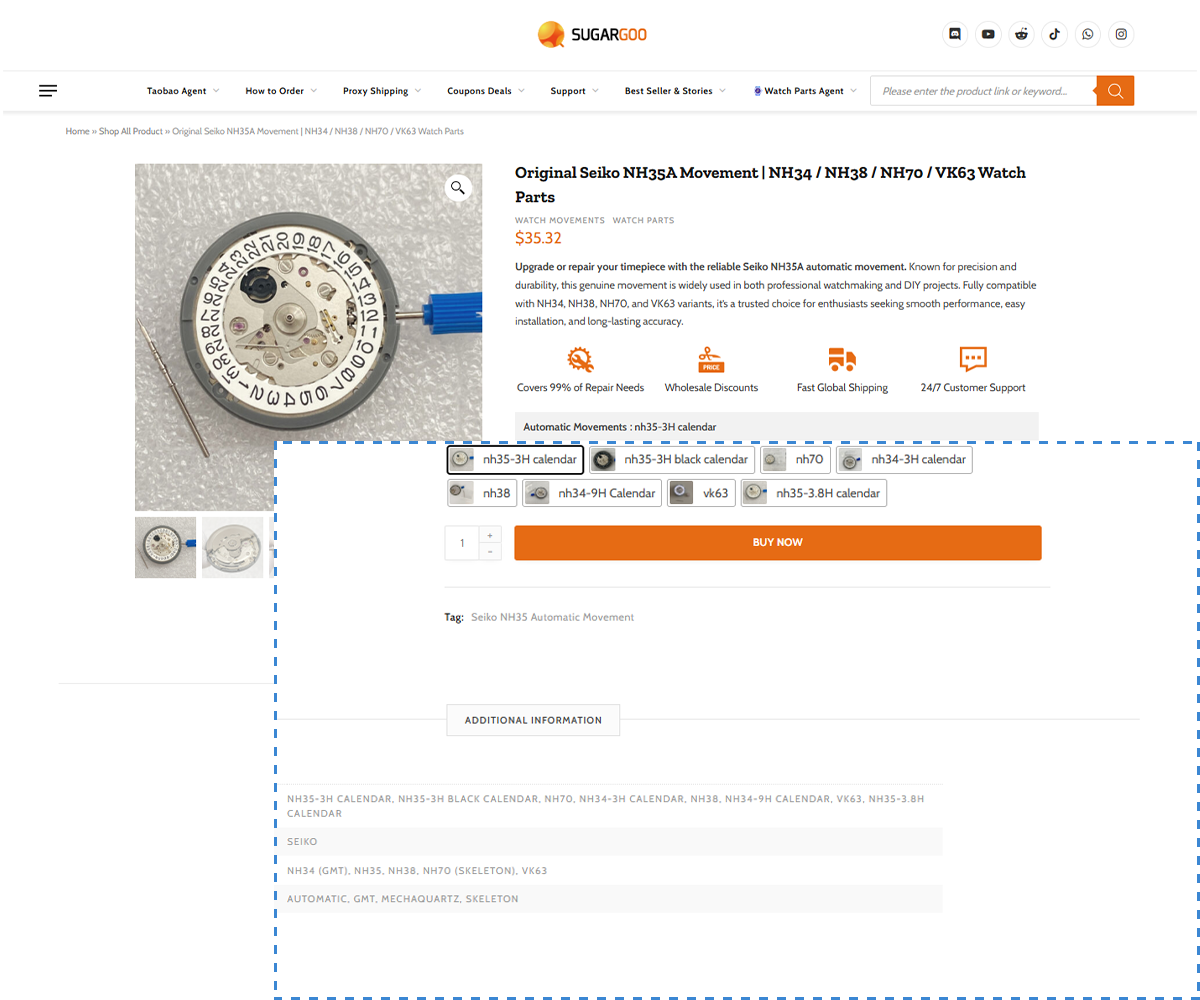There’s a moment every watch builder faces — when the case you started with no longer feels right. Maybe you’ve scratched it. Maybe you’ve outgrown it. Or maybe you’re ready to give your Seiko mod a completely new body.
Replacing a watch case isn’t about fixing mistakes — it’s about upgrading identity. It’s one of the boldest moves a modder can make, turning a familiar watch into something unmistakably personal.
And yes, it’s intimidating the first time. But once you understand how a case interacts with every component — movement, dial, crown, crystal, gasket — you’ll realize it’s just another conversation between metal, glass, and precision.
Why a Case Swap Changes Everything
A new case changes the weight, balance, and feel of your watch more than any dial or strap ever could. It defines the first impression: the curvature against your wrist, the height on your skin, the way light moves across its surface.
For example:
- A brushed SKX-style case gives you that rugged, diver’s presence.
- A pilot-style case with a domed crystal radiates vintage confidence.
- A polished tonneau screams sophistication.
You can spend hours debating dial colors or bezel fonts — but until you swap the case, you haven’t really changed the watch.
The Anatomy of a Case
A case isn’t just a shell — it’s a machine of tolerances. Every millimeter matters. When you replace it, you’re essentially transplanting the heart of your watch into a new body.
The main sections are:
- Case body – holds everything in alignment.
- Bezel – secures the crystal and adds aesthetic tone.
- Case back – protects the movement, sometimes transparent.
- Crown tube – seals the winding stem.
- Lug structure – defines how the strap fits and sits.
Understanding how each part connects makes the replacement process smooth — and scratch-free.
You can explore compatible parts on Sugargoo’s watch cases collection — from SKX conversions to NH35 field builds — all designed to fit Seiko-standard movements.
Tools You’ll Need
Replacing a case requires patience and precision, not brute force. Here’s your essential kit:
- Case back opener – to access the movement.
- Movement holder – keeps the mechanism stable while you work.
- Tweezers and screwdrivers – for crown, stem, and dial screws.
- Hand puller and setter – if you’re removing or reattaching the dial.
- Blower, cleaning cloth, and silicone grease – because dust is your enemy.
All of these can be sourced easily through Sugargoo’s watch repair tools — verified quality without inflated prices.
Step-by-Step: Replacing the Case
- Remove the Movement
Open the back carefully. Unscrew the crown and stem (usually a small release tab near the 3 o’clock position). Gently lift the movement out using plastic tweezers — metal ones can leave scratches.
Place the movement into a watch movement holder and cover it with a dust cap. - Prep the New Case
Inspect the new case under bright light. Check:
– Are the crown threads clean?
– Is the crystal seated evenly?
– Are the gasket grooves intact?
Clean it with a soft blower and a watch cleaning cloth. Apply a tiny bit of silicone grease on the gasket — it makes sealing smooth and secure. - Transfer the Dial and Hands
If you’re upgrading both case and dial, this is where artistry meets mechanics. Use a hand remover to lift the hands cleanly, and align them back later with the precision method from the Watch Hands Alignment Guide.
Handle dials only by the edges — even one fingerprint can ruin a matte finish. - Install the Movement
Once the case is ready, carefully seat the movement inside. It should drop in naturally without force. If it wobbles, check for misaligned tabs or a misfit dial spacer.
Insert the crown and stem — if it doesn’t lock, retract slightly, rotate the stem gently, and retry. You’ll feel the “snap” when it seats correctly. - Seal It Tight
Screw down the case back — or better yet, upgrade to a transparent sapphire case back so you can admire the movement later.
Tighten gently but firmly. Wipe fingerprints. Check the crown operation — winding, setting, and clicking through should feel smooth, not gritty.
If you’ve done everything right, the watch should now feel tighter, cleaner, and distinctly yours.
Understanding Fit and Finish
Case replacement is all about proportion. A millimeter here, a surface polish there — it changes how the watch feels on your wrist.
You’ll notice:
- The weight distribution affects how the strap curves.
- The bezel height changes how light hits your dial.
- The lug angle determines whether the watch hugs or floats.
That’s why professional modders keep multiple cases on hand — so they can match one dial to several personalities.
When you find the perfect combination, it feels inevitable — like it was meant to be this way all along.
Mistakes That Teach You
No matter how careful you are, the first few swaps always teach you humility.
| Mistake | Why It Happens | Lesson |
|---|---|---|
| Stripped threads | Overtightening crown tube | Gentle wins over force |
| Dial scratch | Tool slip or dust under hands | Always use dial protectors |
| Stuck stem | Misaligned clutch lever | Withdraw carefully, reset, retry |
| Misfit gasket | Wrong size or dry seal | Replace every time you open |
| Loose rehaut | Missed alignment pin | Re-seat before securing movement |
Each error teaches control. You’ll find yourself slowing down — and that’s the moment you truly become a modder.
When to Replace vs. When to Restore
Sometimes, a new case isn’t about upgrading — it’s about bringing life back. A scratched Seiko SKX or a corroded diver’s case might look finished, but restoration can be part of the craft too.
Replacing gives you newness. Restoring gives you history. Both belong in the watchmaker’s language of respect.
If you’re into restoration builds, Sugargoo’s movement parts section offers replacements for crowns, stems, and bezels that help rebuild classics without losing character.
The Aesthetic of Precision
Replacing a case is like changing the frame of a painting. The artwork inside stays the same — but the experience changes completely.
A brushed titanium case can turn a playful dial serious. A polished stainless shell can make a tool watch dress-worthy. The more you build, the more you realize: it’s not just about parts. It’s about emotion and balance.
Every case you touch, every thread you tighten, is a quiet exercise in patience. And that’s what makes this craft timeless.
Finding Reliable Cases Online
Not all watch cases are equal — some have poor machining, misaligned crown tubes, or incorrect threading. That’s why experienced builders rely on Sugargoo, the trusted Taobao agent for authentic watch parts.
Through Sugargoo, you can:
- Order NH35-compatible cases directly from verified workshops.
- Bundle bezels, crowns, and crystals in a single shipment.
- Request QC photos before shipping. (See our QC guide.)
- Save on cost using combined order service.
If you’re serious about modding, start where the real builders shop — register on Sugargoo and open your workspace to the world’s biggest watch part market.
The Moment You Know You’ve Done It Right
You screw the case back down. You lift the watch, tilt it toward the light, and everything just aligns — dial centered, hands perfect, glass spotless. The weight feels different — balanced, intentional.
That’s the moment you realize this isn’t a hobby anymore. It’s craft. You’ve replaced a case, but you’ve also reshaped your relationship with time.










